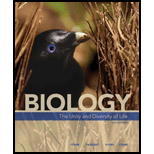
Biology: The Unity and Diversity of Life (MindTap Course List)
15th Edition
ISBN: 9781337408332
Author: Cecie Starr, Ralph Taggart, Christine Evers, Lisa Starr
Publisher: Cengage Learning
expand_more
expand_more
format_list_bulleted
Concept explainers
Question
Chapter 38, Problem 2CT
Summary Introduction
To explain: How does the fetal hemoglobin’s higher affinity towards oxygen benefit a fetus.
Concept introduction: Fetal hemoglobin is the main source of oxygen transport in the human fetus. It is present during the last seven months of the development of the uterus. It persists in the new born until 6 months. In adults, the fetal hemoglobin can be reactivated pharmacologically and can be used in the treatment of diseases.
Expert Solution & Answer
Want to see the full answer?
Check out a sample textbook solution
Students have asked these similar questions
Plating 50 microliters of a sample diluted by a factor of 10-6 produced 91 colonies. What was the originalcell density (CFU/ml) in the sample?
Every tutor here has got this wrong, don't copy off them.
Suppose that the population from question #1 (data is in table below) is experiencing inbreeding depression (F=.25) (and no longer experiencing natural selection). Calculate the new expected genotype frequencies (f) in this population
after one round of inbreeding. Please round to 3 decimal places.
Genotype
Adh Adh
Number of Flies
595
Adh Adh
310
Adhs Adhs
95
Total
1000
fladh Adh-
flAdn Adh
fAdhs Adh
Chapter 38 Solutions
Biology: The Unity and Diversity of Life (MindTap Course List)
Ch. 38 - Prob. 1DAACh. 38 - Smoking and Lung Function Data from the Coronary...Ch. 38 - Smoking and Lung Function Data from the Coronary...Ch. 38 - The respiratory protein hemocyanin _______. a....Ch. 38 - In a _______, air flows continually across the...Ch. 38 - Prob. 3SQCh. 38 - In human lungs, gas exchange occurs at the ______....Ch. 38 - Which holds the most dissolved oxygen? a. warm,...Ch. 38 - When you breathe quietly, inhalation is _______...Ch. 38 - During inhalation _______. a. the thoracic cavity...
Ch. 38 - Prob. 8SQCh. 38 - Most oxygen transported in human blood _______. a....Ch. 38 - At high altitudes, _______. a. nitrogen bubbles...Ch. 38 - Countercurrent flow allows _______ to maximize...Ch. 38 - ______ in arteries sense changes in the acidity of...Ch. 38 - Vital capacity is the _______. a. amount of...Ch. 38 - Prob. 14SQCh. 38 - Match the words with their descriptions. ____...Ch. 38 - Prob. 1CTCh. 38 - Prob. 2CTCh. 38 - Icefish live in the extremely cold ocean near...
Knowledge Booster
Learn more about
Need a deep-dive on the concept behind this application? Look no further. Learn more about this topic, biology and related others by exploring similar questions and additional content below.Similar questions
- Which of the following best describes why it is difficult to develop antiviral drugs? Explain why. A. antiviral drugs are very difficult to develop andhave no side effects B. viruses are difficult to target because they usethe host cell’s enzymes and ribosomes tometabolize and replicate C. viruses are too small to be targeted by drugs D. viral infections usually clear up on their ownwith no problemsarrow_forwardThis question has 3 parts (A, B, & C), and is under the subject of Nutrition. Thank you!arrow_forwardThey got this question wrong the 2 previous times I uploaded it here, please make sure it's correvct this time.arrow_forward
- This question has multiple parts (A, B & C), and under the subject of Nutrition. Thank you!arrow_forwardCalculate the CFU/ml of a urine sample if 138 E. coli colonies were counted on a Nutrient Agar Plate when0.5 mls were plated on the NA plate from a 10-9 dilution tube. You must highlight and express your answerin scientific notatioarrow_forwardDon't copy off the other answer if there is anyarrow_forward
arrow_back_ios
SEE MORE QUESTIONS
arrow_forward_ios
Recommended textbooks for you
 Human Biology (MindTap Course List)BiologyISBN:9781305112100Author:Cecie Starr, Beverly McMillanPublisher:Cengage Learning
Human Biology (MindTap Course List)BiologyISBN:9781305112100Author:Cecie Starr, Beverly McMillanPublisher:Cengage Learning
 Human Physiology: From Cells to Systems (MindTap ...BiologyISBN:9781285866932Author:Lauralee SherwoodPublisher:Cengage Learning
Human Physiology: From Cells to Systems (MindTap ...BiologyISBN:9781285866932Author:Lauralee SherwoodPublisher:Cengage Learning


Human Biology (MindTap Course List)
Biology
ISBN:9781305112100
Author:Cecie Starr, Beverly McMillan
Publisher:Cengage Learning



Human Physiology: From Cells to Systems (MindTap ...
Biology
ISBN:9781285866932
Author:Lauralee Sherwood
Publisher:Cengage Learning
